FREE US SHIPPING ON ALL BOOKS
STANDARD LINES
Book III in the Constructing Walking Jazz Bass Lines Series
STANDARD LINES - jazz standards, bebop , latin jazz
For the ELECTRIC BASSIST
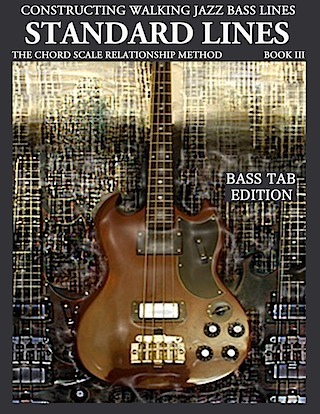
Example 1. from inside the book
An excerpt form Pt 1
How to apply the Modes and the Chord
scale relationships to standard jazz chord progressions
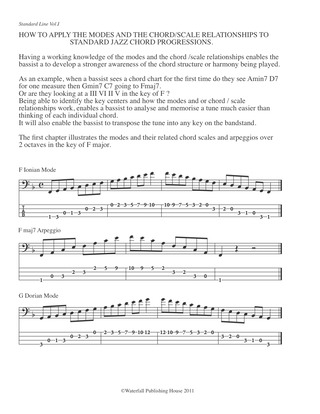
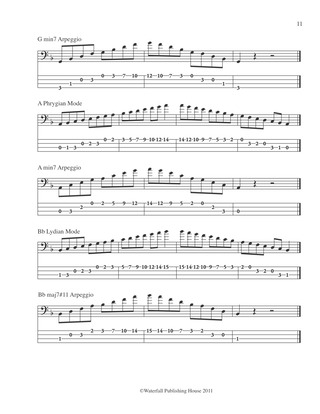
Example 2 Scalar approaches to constructing
walking jazz bass lines " ascending "
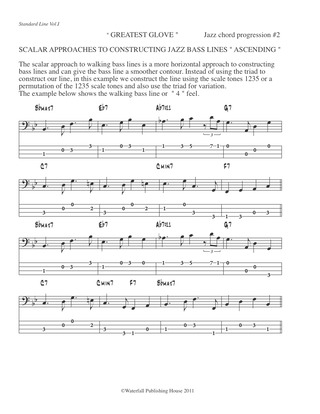
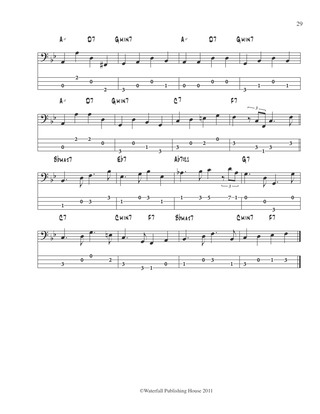
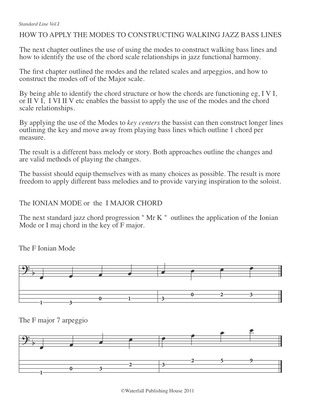
FOREWARD
Standard Lines, Book III in the Constructing Walking Jazz Bass
Lines series for the Electric Bassist is a
comprehensive guide demonstrating the devices used to construct
walking jazz bass lines in the jazz standard tradition.
Book III covers 24 standard jazz chord progressions with 110 choruses
of professional jazz bass lines as an example.
Part I outlines the Modes and the chord scale relationships and the
fundamental knowledge required to be able to build the diatonic triads
and 7th chords in any key. Examples are given in the " 2 " feel and " 4 "
feel walking bass style enabling the bassist to develop a strong
rhythmic and harmonic foundation.
More advanced bass line construction examples including voice
leading and mode substitutions and mode applications related to specific
jazz chord progressions are also outlined.
Part II outlines the Symmetric Scales as well as the Modes of the
Melodic Minor Scale related to the Minor II V I progression.
Provided are written examples of the Symmetric Scales and the chord
scale relationships and how to apply the use of the Symmetric Scales
over popular jazz chord progressions.
The Minor II V I is outlined and compared to the Major II V I
outlining the differences with the suggested scale uses applied to
common jazz chord progressions.
Part III outlines the use of the BeBop Scales and their use in the jazz
walking bass tradition, providing suggested uses of the Be Bop scales
related to popular jazz chord progressions.
Part IV outlines the previous lesson devices and concepts with
examples of professional level bass lines over standard jazz chord
progressions.
All information builds in a stepwise progression enabling the bassist to
apply the techniques in all 12 keys.
TABLE OF CONTENTS
Part 1
The Chord Scale Relationships .....................................................
How to apply the Modes and chord scale relationships to
standard chord progressions...........................................................
How to construct the triads off of the major scale .........................
Jazz chord progression # 1 " Periodic "
Bass Line Construction Triads and the " 2 " feel ...........................
Triads " 4 " feel walking bass line .................................................
Triads and the chromatic approach from above .............................
Triads and the chromatic approach from below .............................
Triads and the Walk Up ................................................................
Triads and the Walk Down ...........................................................
Jazz chord progression # 2 " Greatest Glove "
Scalar approaches to constructing bass lines " ascending " .............
Applying 7th chords to scalar bass lines
How to construct the diatonic 7ths ...............................................
Applying 7th chords to scalar bass lines " descending "..................
Ascending scalar with chromatic approach from above .................
Descending scalar with chromatic approach from below ...............
Voice leading 7th chords & the II V I progression ........................
Jazz chord progression # 3 " Winters Coming "
Applying the voice leading technique to bass lines ........................
Voice leading the Dominant 7th chord .........................................
How to apply the Modes to constructing walking jazz bass lines
The Ionian mode .........................................................................
Jazz chord progression # 4 " Mr. K " .............................................
The Major II V I progression and the the Dorian &
Mixolydian modes .......................................................................
The II V I progression .................................................................
The application of the II V I progression in jazz chord
progressions .................................................................................
The III VI II V progression and the Phyrgian mode .....................
The III VI II V I progression ......................................................
The application of the III VI II V I progression in jazz
chord progressions .......................................................................
The I VI II V progression and the Aeolian mode .........................
The application of the I VI II V progression in jazz
chord progressions .......................................................................
The Lydian mode .........................................................................
Jazz chord progression # 5 " It Depends "
Applying the Lydian Mode to constructing jazz bass lines ............
The Locrian Mode .......................................................................
Jazz chord progression # 6 " The Weaving Stream " ....................
Applying the Locrian Mode to constructing jazz bass lines ..........
Part II
Symmetric & Melodic Minor Scales ............................................
The Whole Tone scale
Jazz chord progression # 7 " Wheres the subway ? " ....................
The Diminished scale ..................................................................
Jazz chord progression # 8 " Finding Candy "
Applying the use of the Diminished scale .....................................
The Half Whole Diminished scale ...............................................
Jazz chord progression # 9 " Vegetable Stew "
Applying the use of the Half Whole Diminished scale .................
The Diminished Whole Tone scale & the
Minor II V progression ...............................................................
Jazz chord progression # 10 " Moonlight View "
Applying the use of the diminished whole tone scale ....................
The Locrian # 2 & the Minor II V progression ...........................
Applying the use of the Locrian # 2 scale .....................................
The Minor II V progression .........................................................
Part III
The Bebop Scales
The ascending Major Bebop scale .................................................
The descending Major Bebop scale ...............................................
Jazz chord progression # 11 " More Stew ? "
Applying the use of the Major Bebop scale ...................................
The ascending Dorian minor Bebop scale .....................................
The descending Dorian minor Bebop scale ...................................
Jazz chord progression # 12 " Heard It "
Applying the use of the Dorian Minor bebop Scale ......................
The ascending Mixolydian Bebop scale .........................................
The descending Mixolydian Bebop scale .......................................
Jazz chord progression # 13 " Who's Glove ? "
Applying the use of the Mixolydian Bebop Scale ..........................
Part IV Jazz Bass Line examples over standard Jazz
chord progressions .......................................................................
Jazz chord progression # 14 " Ocean St " ....................................
Jazz chord progression # 15 " Slipped into the Stream " ..............
Jazz chord progression # 16 " Only You " ....................................
Jazz chord progression # 17 " The One in Gloves " ...................
Jazz chord progression # 18 " Garden Hoses " ...........................
Jazz chord progression # 19 " Who Are You ? " .........................
Jazz chord progression # 20 " Idiosyncrasy "...............................
Jazz chord progression # 21 " The Third " .................................
Jazz chord progression # 22 " New Gloves " ..............................
Jazz chord progression # 23 " Bring Your Strings " ....................
Jazz chord progression # 24 " No Ones Here " ..........................
In Conclusion .............................................................................


